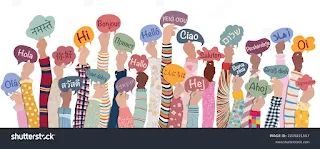Description: Language-based discrimination refers to the unfair treatment of individuals based on the language they speak. In India, a country with over 120 major languages and 22 scheduled ones, linguistic diversity is both a strength and a challenge. Unfortunately, this diversity sometimes leads to biases, exclusion, or even hostility against speakers of non-dominant or regional languages. Affected Groups: Non-Hindi speakers in North India (e.g., Tamils, Malayalis, Bengalis, Assamese) Hindi speakers in South India (e.g., migrants from Uttar Pradesh or Bihar in Tamil Nadu or Karnataka) Tribal language speakers (e.g., Santhali, Bhili, Gondi communities) Minority language speakers (e.g., Urdu, Konkani, or Kashmiri speakers) I. The Nature of Language-Based Discrimination Language is closely tied to identity. In India, people often associate language with culture, pride, and regional belonging. But when linguistic differences become a basis for discrimination, it leads to exclusion in edu...
Description:
Language-based discrimination refers to the unfair treatment of individuals based on the language they speak. In India, a country with over 120 major languages and 22 scheduled ones, linguistic diversity is both a strength and a challenge. Unfortunately, this diversity sometimes leads to biases, exclusion, or even hostility against speakers of non-dominant or regional languages.
Language is closely tied to identity. In India, people often associate language with culture, pride, and regional belonging. But when linguistic differences become a basis for discrimination, it leads to exclusion in education, employment, governance, and daily social interaction.
Examples include:
Mockery of accents in classrooms or workplaces.
Denial of housing or jobs to people speaking a “non-local” tongue.
Regional governments making official communication only in the state language, thereby excluding migrants.
Demands to learn the local language as a condition to access public services.
II. Legal Framework in India Against Language Discrimination
India’s Constitution provides protection to all languages and discourages discrimination based on language.
1. Article 14 – Right to Equality
Guarantees equality before the law. Discrimination based on language is a violation of this article.
2. Article 15(1) – Prohibition of Discrimination
Says: “The State shall not discriminate against any citizen on grounds only of religion, race, caste, sex, place of birth, or any of them.” Language is considered part of “place of birth” related identity.
3. Article 16 – Equality in Public Employment
No citizen can be denied employment under the State on the grounds of language or place of birth.
4. Article 29(1) – Protection of Interests of Minorities
It allows any section of citizens with a distinct language, script or culture to preserve it.
5. Article 350A – Instruction in Mother Tongue
Directs states to provide primary education in children’s mother tongues, especially for linguistic minorities.
6. Article 350B – Special Officer for Linguistic Minorities
Provides for an officer to report on the rights and conditions of linguistic minorities.
7. Official Languages Act, 1963
This Act allows the use of both Hindi and English for official purposes. States are also free to adopt their own official languages, ensuring linguistic autonomy.
III. Real-Life Scenarios and Incidents
1. Anti-Hindi Agitations in Tamil Nadu
Since the 1930s and especially in the 1960s, Tamil Nadu has resisted the imposition of Hindi in education and administration. Even today, efforts to make Hindi compulsory face protests.
2. Attacks on Hindi Speakers in Maharashtra
In cities like Mumbai, migrants from Uttar Pradesh and Bihar have faced violence and abuse for not speaking Marathi.
3. Bias in Government Exams
Many national-level competitive exams (like UPSC prelims or banking) are either not available in regional languages or translations are poor, putting non-Hindi speakers at a disadvantage.
4. North Indians in Bengaluru or Chennai
Hindi speakers often complain that they are insulted, ignored, or excluded in places where the local language (Kannada or Tamil) dominates, especially in auto stands, small businesses, or public offices.
5. Tribal and Minority Language Neglect
Languages like Santhali or Bodo are rarely represented in mainstream media or governance, making speakers feel marginalized.
IV. Language and Education
Language-based exclusion begins in the classroom:
Medium of instruction often favors dominant regional or national languages.
Mocking of dialects or accents by peers or even teachers.
NEET (National Eligibility-cum-Entrance Test) is another example where Hindi and English dominated the exam format until recently.
Despite Article 350A, mother-tongue education remains a challenge for tribal or minority communities due to lack of infrastructure, trained teachers, and resources.
V. Social and Cultural Consequences
Urban housing bias: Owners often say “Only Tamil/Kannada-speaking tenants preferred”.
Interpersonal exclusion: Mocking someone’s accent or telling them to “speak properly” causes humiliation.
Cinema and Media dominance: Bollywood (Hindi cinema) dominates the Indian cultural narrative. Regional industries get less national attention, especially from North India.
VI. Political Manipulation
Regional political parties often use language identity to rally support. While this can protect regional languages, it sometimes turns hostile against other language groups. For example:
Demanding mandatory language tests for jobs in Karnataka (Kannada language).
Protests against signboards in Hindi in Tamil Nadu.
Denial of government services if the person doesn’t speak the state’s language.
VII. Need for Policy-Level Interventions
To counter language-based discrimination, the following are essential:
Multilingual public services: All official notices, websites, and services should be available in major regional languages.
Fair translation in exams: National exams must be accurately and fairly translated.
Encouragement of linguistic diversity: Schools should introduce multiple languages early, with an option to choose.
Awareness campaigns: Promote unity in diversity through campaigns that celebrate India’s multilingual character.
VIII. The Role of Judiciary
Courts have often stood for linguistic rights. For instance:
P.A. Inamdar vs. State of Maharashtra (2005): The court emphasized the right of minorities to establish and administer institutions in their own language.
TMA Pai Foundation vs. State of Karnataka (2002): Upheld the autonomy of institutions to use their preferred language of instruction.
Conclusion
Language should be a tool of communication, not a weapon of exclusion. India’s diversity is unmatched, but so is its potential for discrimination when language becomes a barrier. From housing to employment to education, the challenge is to move from linguistic hierarchy to linguistic harmony. With the right policies and social attitudes, every Indian – regardless of their mother tongue – can truly feel at home.
Language-based discrimination refers to the unfair treatment of individuals based on the language they speak. In India, a country with over 120 major languages and 22 scheduled ones, linguistic diversity is both a strength and a challenge. Unfortunately, this diversity sometimes leads to biases, exclusion, or even hostility against speakers of non-dominant or regional languages.
Affected Groups:
Non-Hindi speakers in North India (e.g., Tamils, Malayalis, Bengalis, Assamese)
Hindi speakers in South India (e.g., migrants from Uttar Pradesh or Bihar in Tamil Nadu or Karnataka)
Tribal language speakers (e.g., Santhali, Bhili, Gondi communities)
Minority language speakers (e.g., Urdu, Konkani, or Kashmiri speakers)
Non-Hindi speakers in North India (e.g., Tamils, Malayalis, Bengalis, Assamese)
Hindi speakers in South India (e.g., migrants from Uttar Pradesh or Bihar in Tamil Nadu or Karnataka)
Tribal language speakers (e.g., Santhali, Bhili, Gondi communities)
Minority language speakers (e.g., Urdu, Konkani, or Kashmiri speakers)
I. The Nature of Language-Based Discrimination
Language is closely tied to identity. In India, people often associate language with culture, pride, and regional belonging. But when linguistic differences become a basis for discrimination, it leads to exclusion in education, employment, governance, and daily social interaction.
Examples include:
Mockery of accents in classrooms or workplaces.
Denial of housing or jobs to people speaking a “non-local” tongue.
Regional governments making official communication only in the state language, thereby excluding migrants.
Demands to learn the local language as a condition to access public services.
II. Legal Framework in India Against Language Discrimination
India’s Constitution provides protection to all languages and discourages discrimination based on language.
1. Article 14 – Right to Equality
Guarantees equality before the law. Discrimination based on language is a violation of this article.
2. Article 15(1) – Prohibition of Discrimination
Says: “The State shall not discriminate against any citizen on grounds only of religion, race, caste, sex, place of birth, or any of them.” Language is considered part of “place of birth” related identity.
3. Article 16 – Equality in Public Employment
No citizen can be denied employment under the State on the grounds of language or place of birth.
4. Article 29(1) – Protection of Interests of Minorities
It allows any section of citizens with a distinct language, script or culture to preserve it.
5. Article 350A – Instruction in Mother Tongue
Directs states to provide primary education in children’s mother tongues, especially for linguistic minorities.
6. Article 350B – Special Officer for Linguistic Minorities
Provides for an officer to report on the rights and conditions of linguistic minorities.
7. Official Languages Act, 1963
This Act allows the use of both Hindi and English for official purposes. States are also free to adopt their own official languages, ensuring linguistic autonomy.
III. Real-Life Scenarios and Incidents
1. Anti-Hindi Agitations in Tamil Nadu
Since the 1930s and especially in the 1960s, Tamil Nadu has resisted the imposition of Hindi in education and administration. Even today, efforts to make Hindi compulsory face protests.
2. Attacks on Hindi Speakers in Maharashtra
In cities like Mumbai, migrants from Uttar Pradesh and Bihar have faced violence and abuse for not speaking Marathi.
3. Bias in Government Exams
Many national-level competitive exams (like UPSC prelims or banking) are either not available in regional languages or translations are poor, putting non-Hindi speakers at a disadvantage.
4. North Indians in Bengaluru or Chennai
Hindi speakers often complain that they are insulted, ignored, or excluded in places where the local language (Kannada or Tamil) dominates, especially in auto stands, small businesses, or public offices.
5. Tribal and Minority Language Neglect
Languages like Santhali or Bodo are rarely represented in mainstream media or governance, making speakers feel marginalized.
IV. Language and Education
Language-based exclusion begins in the classroom:
Medium of instruction often favors dominant regional or national languages.
Mocking of dialects or accents by peers or even teachers.
NEET (National Eligibility-cum-Entrance Test) is another example where Hindi and English dominated the exam format until recently.
Despite Article 350A, mother-tongue education remains a challenge for tribal or minority communities due to lack of infrastructure, trained teachers, and resources.
V. Social and Cultural Consequences
Urban housing bias: Owners often say “Only Tamil/Kannada-speaking tenants preferred”.
Interpersonal exclusion: Mocking someone’s accent or telling them to “speak properly” causes humiliation.
Cinema and Media dominance: Bollywood (Hindi cinema) dominates the Indian cultural narrative. Regional industries get less national attention, especially from North India.
VI. Political Manipulation
Regional political parties often use language identity to rally support. While this can protect regional languages, it sometimes turns hostile against other language groups. For example:
Demanding mandatory language tests for jobs in Karnataka (Kannada language).
Protests against signboards in Hindi in Tamil Nadu.
Denial of government services if the person doesn’t speak the state’s language.
VII. Need for Policy-Level Interventions
To counter language-based discrimination, the following are essential:
Multilingual public services: All official notices, websites, and services should be available in major regional languages.
Fair translation in exams: National exams must be accurately and fairly translated.
Encouragement of linguistic diversity: Schools should introduce multiple languages early, with an option to choose.
Awareness campaigns: Promote unity in diversity through campaigns that celebrate India’s multilingual character.
VIII. The Role of Judiciary
Courts have often stood for linguistic rights. For instance:
P.A. Inamdar vs. State of Maharashtra (2005): The court emphasized the right of minorities to establish and administer institutions in their own language.
TMA Pai Foundation vs. State of Karnataka (2002): Upheld the autonomy of institutions to use their preferred language of instruction.
Conclusion
Language should be a tool of communication, not a weapon of exclusion. India’s diversity is unmatched, but so is its potential for discrimination when language becomes a barrier. From housing to employment to education, the challenge is to move from linguistic hierarchy to linguistic harmony. With the right policies and social attitudes, every Indian – regardless of their mother tongue – can truly feel at home.




Comments
Post a Comment